.png)

Last updated on
February 21, 2024
Email marketers focus on the subject lines, email copy, images, and call to action buttons in their emails but forget a very significant part of the email: the email footer.
Established brands use this space wisely, making their email marketing campaigns successful.
So, what are the things that are included in an email footer? What are the tips that can help you design highly effective email footers? And what are different brands doing to make their email campaigns so successful?
This blog answers these questions by highlighting the best practices and email footer examples of industry-leading brands.
An email footer is the bottom section of an email that includes essential information such as the sender's name, contact information, and company logo.
The footer can also have a call-to-action (CTA) button or links to social media profiles. Email footers are essential because they provide the recipients with all necessary information about a brand in a designated space.
48% of digital marketers use email footers and email signatures to bring traffic to their websites. A survey conducted revealed that 82% of the respondents said brand awareness is the most important aspect of email signature marketing.
Therefore, email marketers should pay attention to email footers to optimize the email design.
Given here is an example of what a basic email footer looks like.

An email signature is a block of text that is automatically added at the end of emails. It typically contains the sender's name, contact information, and company logo. Sometimes it also consists of the sender’s job designation in the company.
An email signature aligns with the company's image. They don't necessarily have to be added for marketing purposes. For instance, students can add email signatures to make their emails more professional when submitting an assignment.
A company employee uses them for internal communication. Their emails contain personal information like their full name and designation.
On the other hand, an email footer is a section of an email that includes essential information such as the sender's name, contact information, and company logo. The footer can also have a call-to-action (CTA) button or links to social media profiles (the key difference). Also, email footers are used specifically for marketing purposes.
The email footer doesn't contain information about the sender. Rather, it contains information regarding the company.
There are several reasons why someone should include an email footer in their messages. First, email footers give recipients all the important information they need to know about a company.
Second, email footers help prevent the emails from going to spam. This is because most spam filters look for key phrases in the body of an email before sending them to the recipient's inbox. If an email contains a footer with important information about a company, it is less likely to be caught by a spam filter.
Email marketing is responsible for 50% of B2B lead generation, followed closely by Search Engine Optimization (SEO) at 43%.
Content marketing is at third with 34%. Therefore, emails are the leading source of communication between businesses and customers. And, adding an email footer can enhance the chances of leads converting.
There are several ways to add a footer to an email. The most common way is to use an email signature generator. This will allow you to create a professional-looking signature that can then be added to the end of the messages.
Another way to add a footer is to create one using an HTML tag. This is a good option if you want to include links or images in the footer.
Finally, you can also use a pre-designed custom template. This is the easiest way to add a footer to the email, but it may not be as customizable as other options. That’s why email marketers are keen to use email marketing platforms that offer pre-built email marketing templates for convenience.
Mailmunch offers a highly intuitive drag and drop builder for email footers. Use the elements given on the left-hand side of the dashboard and place them at the bottom of the email template. Add images, text, or links in the email footer that you want, and create highly engaging email footers.
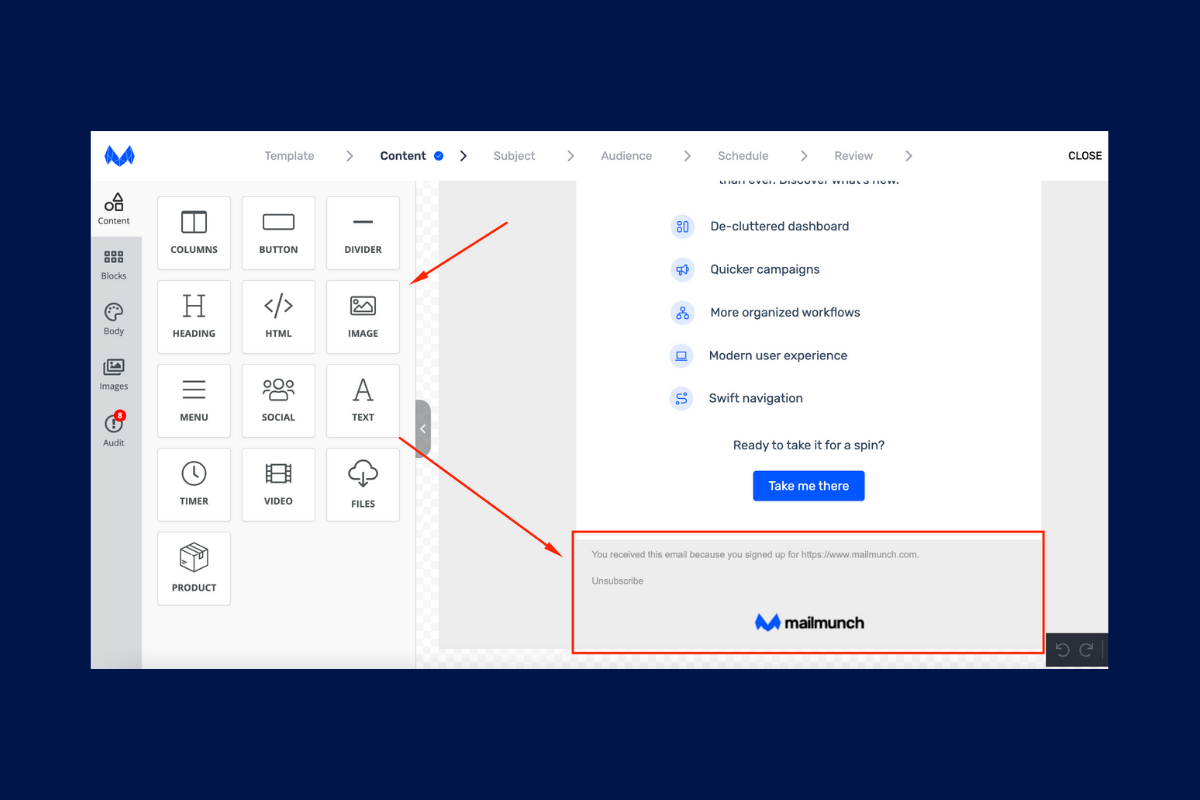
Now that you know why is it important to include an email footer, it is time to learn what to include in it. Here are 17 things to include in your email footer:
As a small gesture, adding an email footer thank you note can go a long way towards increasing customer loyalty and engagement.
They'll feel appreciated, which means they're more likely to take another look at what else you have for sale.
For example, look at the email footer of Huckberry, an apparel, and fashion brand. They are thanking a subscriber for signing up and becoming a part of their one million-strong community. Also, they are asking the subscriber to refer them to a friend. At the bottom, they have provided a clear unsubscribe option for the unsubscribers to opt-out any time.
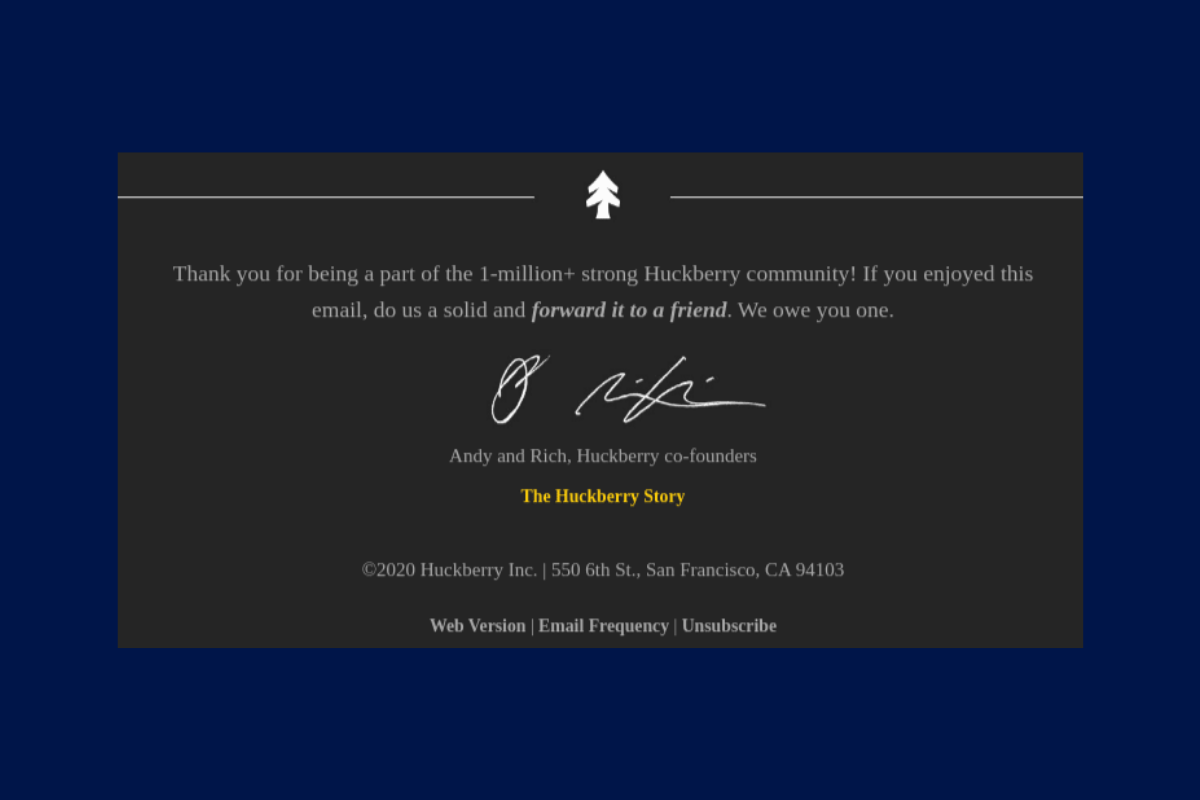
Email footers are often overlooked as an important element of email design. However, they can be a powerful tool for reinforcing a brand's mission and values.
By including your brand’s mission and values in the email footer, remind recipients of why they subscribed to your emails in the first place. In addition, including the mission and values in your email footer will help to create a sense of trust and transparency with your subscribers.
A call-to-action (CTA) button in your email footer effectively encourages the recipients to take action. This could be a link to the website, a landing page, or a product page. Including a CTA button in your email footer increases the likelihood that recipients will take the desired action.
Use branded links that have your domain name as the CTAs. Also, use banners or HTML buttons to attract the recipients to take action.
The most effective email footers include a distinct CTA button that stands out from the rest of the text. It should be placed prominently in the email footer, and the text should be clear and concise (less than 50 characters).
For example, Readymag, a website design platform, is announcing its partnership with the .xyz domain and offering its users free access to a .com domain if they upgrade to a paid plan. They have added a CTA, “Details”, to entice recipients to take action and learn more about the offer.
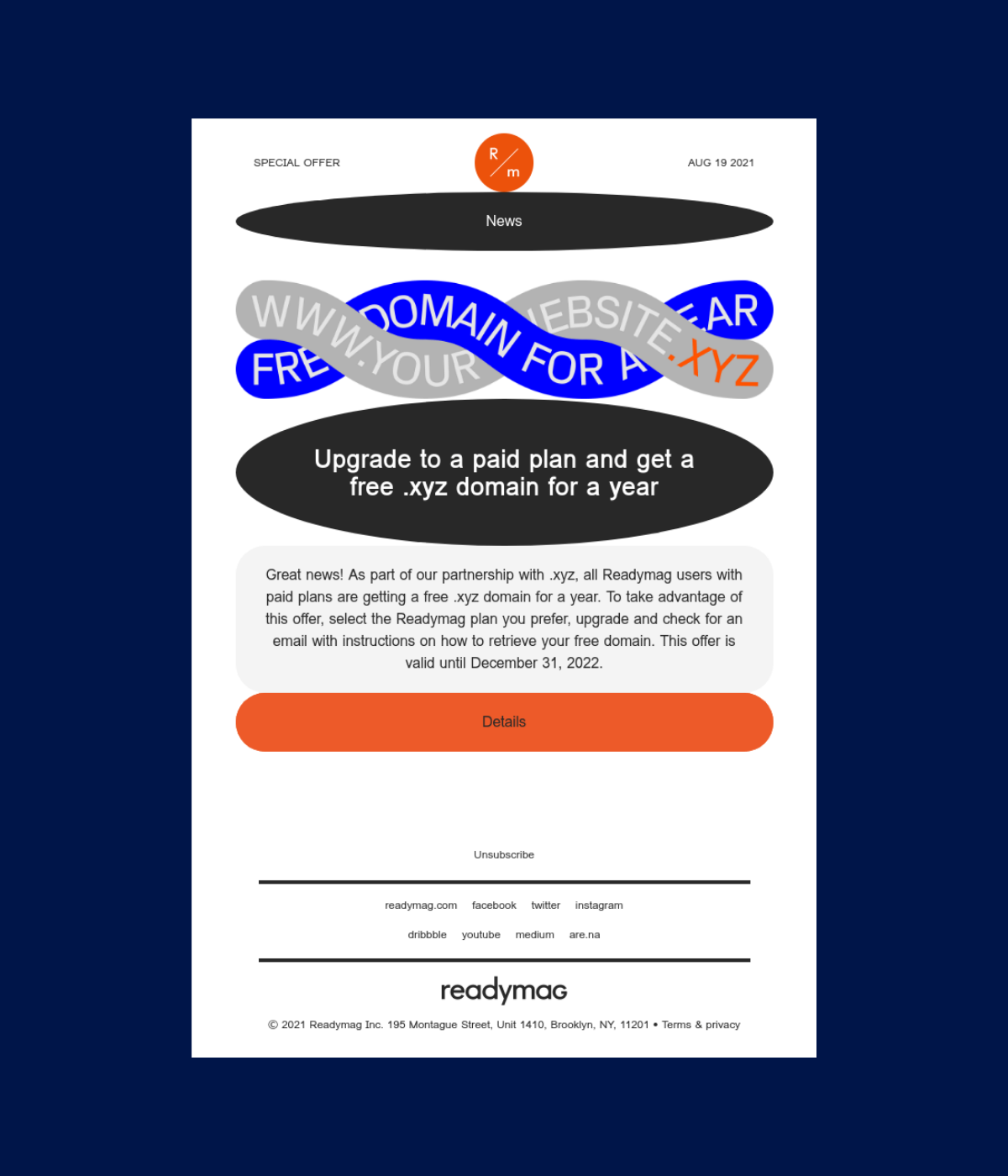
It's important to give subscribers the option to opt-out of your emails if they no longer wish to receive them. The best way to do this is to include an unsubscribe link in the email footer.
This will allow subscribers to unsubscribe from the list without contacting you. Including an unsubscribe link is a best practice and will help avoid spam complaints.
For example, YouTube sends emails to its users with unsubscribe links embedded in the footer.
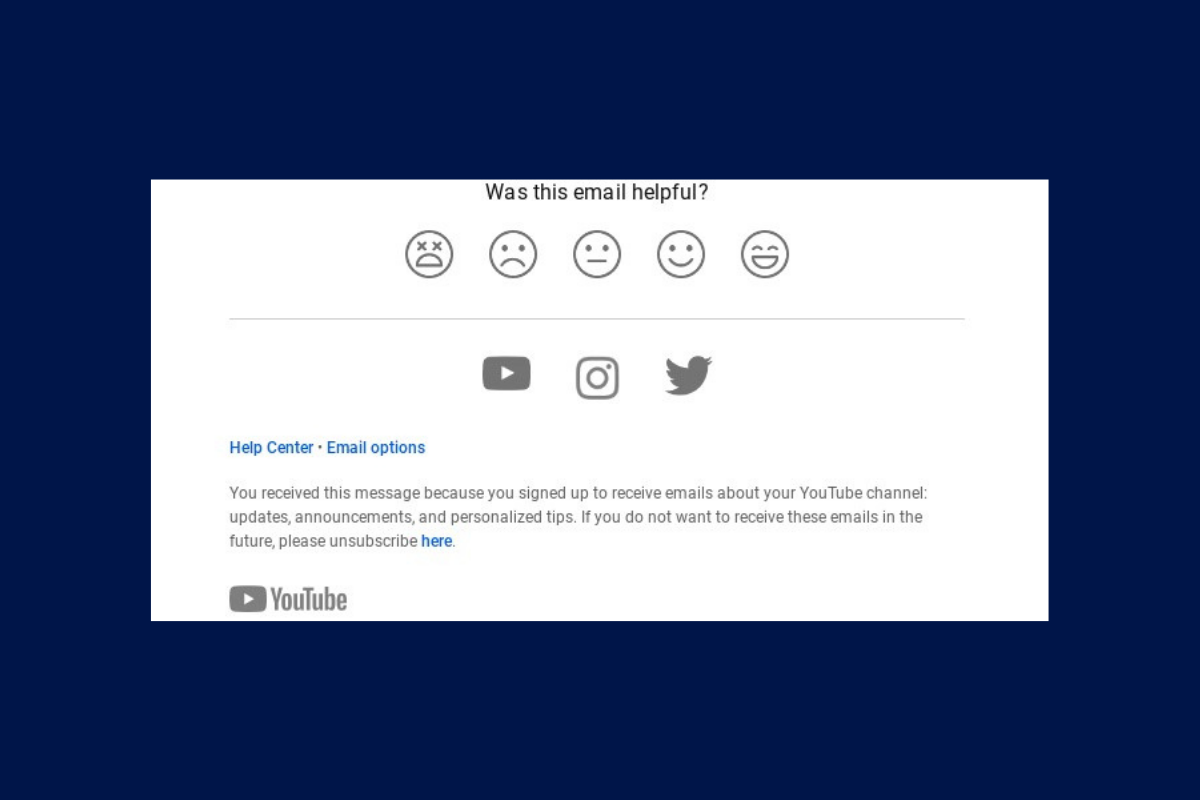
The email footers should include a link to the preference center so subscribers can update their preferences and be more in control of how they want to engage with the emails.
Doing so will help ensure the subscribers’ engagement with the emails. Moreover, subscribers will be regularly updated about the content they want to see.
For example, Atlassian, a project management software company, sends emails with the “manage preference section” in the footer. They also include links to their social media handles, privacy policy, blog, and community link. Moreover, they have mentioned their office address.
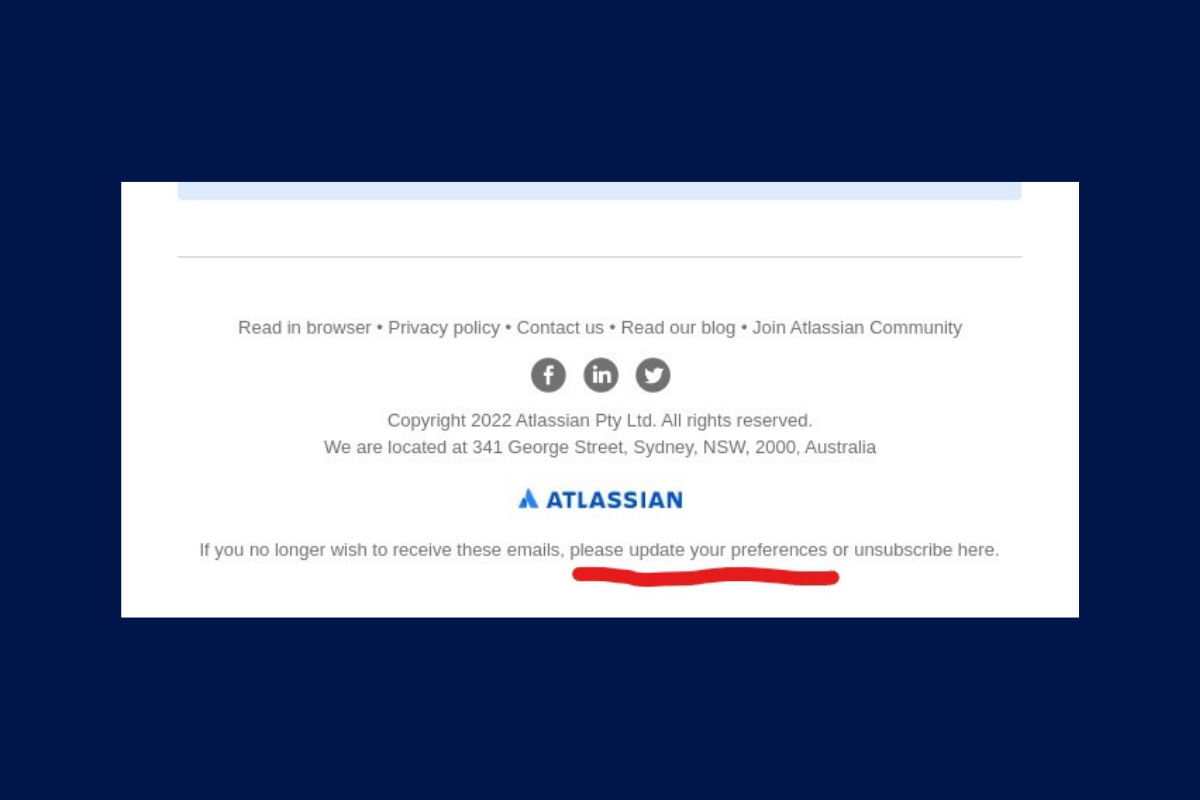
Email footers are often an afterthought when it comes to design, but they can be quite powerful in building trust with recipients. Including a link to your privacy policy or terms and conditions is an excellent way to give recipients peace of mind that their personal information is safe.
If you're doing business in the European Union, make sure that you're compliant with GDPR. Add a link to your privacy policy in your email footer so that recipients can review it.
For example, Sketch, a graphic editing software, includes its privacy policy in its email footers under the “Privacy Statement.” And as Sketch B.V is a Dutch company that developed this software, therefore, their privacy policy complies with GDPR of the EU.

Adding a testimonial from a satisfied customer is also a great way to build trust, as it shows that you're not just blowing smoke about your products or services. Including social proof in the email footer can also help boost confidence in the brand. If you have any kind of stats or awards that you've won, consider adding them to your email footer.
Ultimately, the key is to include any information that will help build trust with recipients and encourage them to do business with you.
Printful, a designing and printing company, includes social proof in the email footers. They have delivered 31.9 million items since 2013.
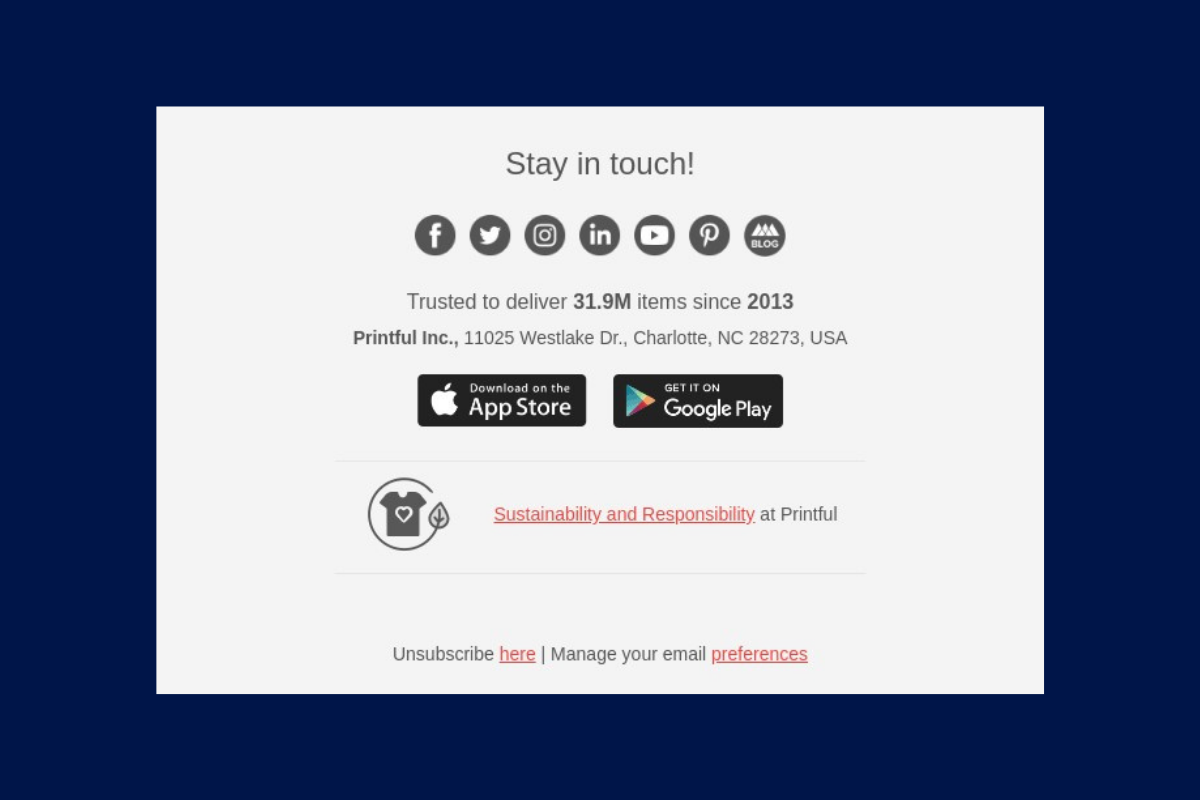
If you want recipients to connect with you on social media, include links to the social media profiles in your email footer. It will make it easy for recipients to find and follow you on social media, and they'll be more likely to engage with the content.
It's also important to include contact information in your email footer if recipients have any questions or concerns. It could include your email address, business phone number, or mailing address. The more contact information you include, the easier it will be for recipients to get in touch. Adding a link to a Google Maps pin could work if they want to visit in person.
For example, Ando, a financial services company, includes links to its social media pages such as Facebook, Instagram, and Twitter. The company’s official address, phone number, and customer success team email address are also included in the footer.

Including links to your website and blog in the email footer is a great way to drive traffic to your site and keep recipients engaged with the content.
Also, if you have launched new products, then adding a link to your website in the footer can help generate traffic to those product pages.
For example, Fitbit has added a link to its blog for information regarding its new products.
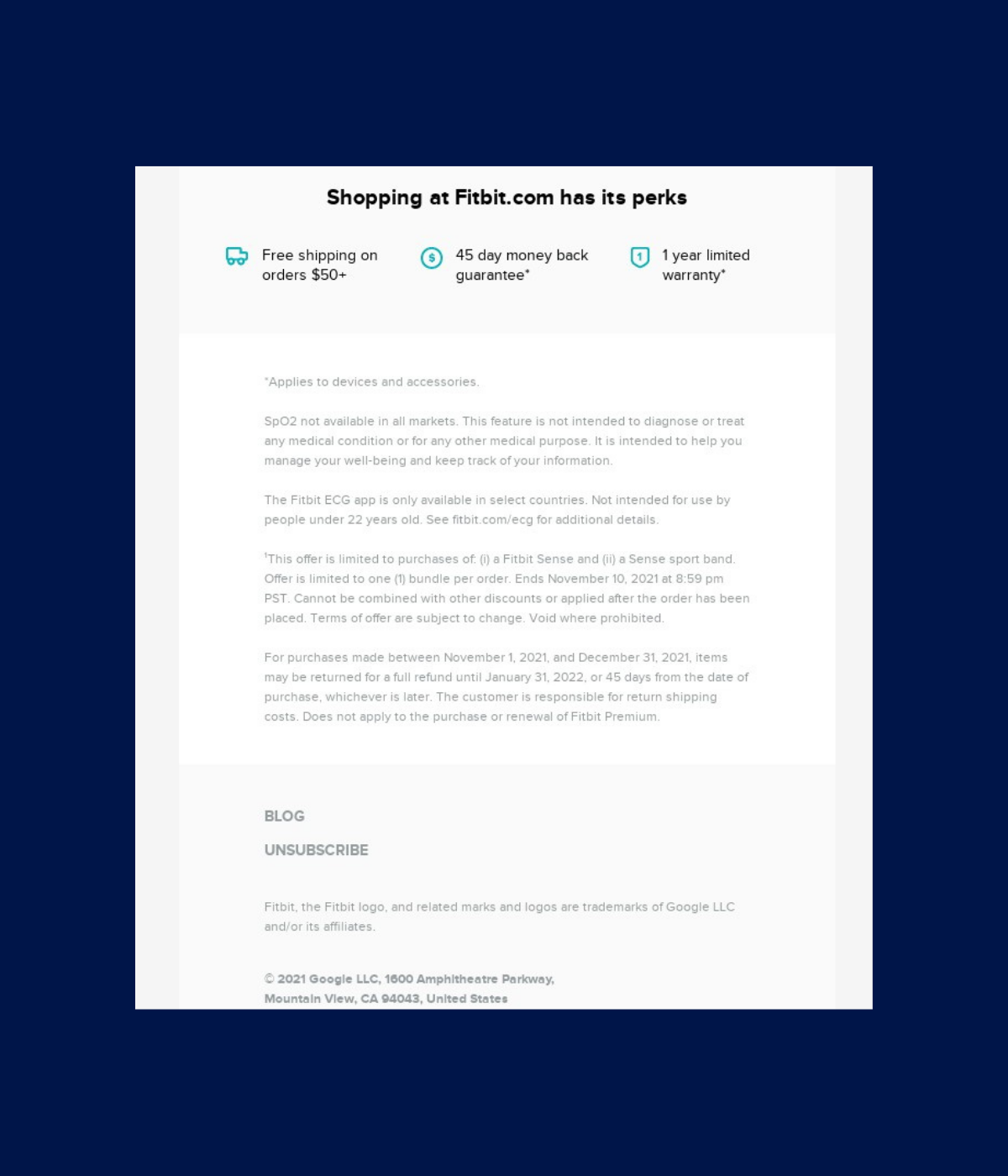
Also, Bridge & Burn is offering father’s day exclusive giveaways in collaboration with seven other brands. They have linked the new arrivals in the footer.

Make sure to include links of your mobile app in the email footer so that recipients can find and download it. They'll be more likely to use the software if they're already familiar with who developed it.
In addition, this will also help to promote the app and increase its visibility.
For example, Thumbtack, a home services company, has added the links to its App for both Android and IOS, in the email footer. It has also added an unsubscribe link, community link, and terms & conditions link.

If you're having trouble getting your emails delivered to recipients' inboxes, you may want to consider adding a white list request to your email footer. This will help that your emails are delivered and that they're not being filtered out as spam.
Also, include instructions on how recipients can whitelist your email address so that they can continue receiving the emails. This is a good way to ensure that the emails are getting through and that recipients are seeing them.
Including a white list request in the email footer is a good way to improve email deliverability and ensure that your messages are getting through to recipients.
If you want to encourage recipients to refer friends, family, or colleagues to your business, include referral links in the email footer. This will make it easy for recipients to share the content with their friends and followers.
By making it easy for recipients to share your content, you can reach a wider audience and generate more leads.
If you want to provide recipients with more information about the products or services, consider adding FAQs to your email footer. It helps answer any questions that recipients may have and give them the information to make a decision.
You can increase recipients' understanding of your business by answering common questions and building trust. Also, add the link to your customer support so that the recipient can directly ask them the questions.
For example, CodePen, a community for testing CSS and Javascript codes, added a support link in its email footers to guide its subscribers if they have questions.

Adding the company logo to the email footer is a good way to build brand recognition and show recipients who you are. This will help recipients remember your company, and they'll be more likely to do business with you in the future.
Including your company address in the email footer is also a good way to build trust with recipients.
For example, Danner, a fashion brand, includes its brand logo and company address in the footer of its emails. Moreover, it also includes its social media links as well.

If you're sending sensitive information in the emails, you may want to include a security disclaimer in your email footer. This will let recipients know that their information is confidential and will not be shared with anyone.
For example, Stacks, a decentralized apps open-source network, has added a security disclaimer in the header that disclaims that Blockstack PBC is not registered or licensed by the Security and Exchange Commission (SEC) of the USA.

If you want to be environmentally friendly, include a green email footer. Let the recipients know that they can expect lower carbon emissions from reading emails on a screen instead of printing them. Show conviction that you are determined to fight climate change.
To create a top-notch email footer, adhere to these 7 tips:
The email footer is not the place to put a novel. Keep the messaging short, sweet, and to the point in the footer. You want recipients to be able to quickly scan the information and find what they're looking for without getting overwhelmed.
Look what Dossier, a perfume brand, has included in its email footer. It has included only the necessary information in the form of vector icons. Also, it has linked its social media handles in the footer, privacy policy, terms & conditions, and an unsubscribe link at the bottom.

With more and more people reading emails on their phones, it's important to make sure that the email footer is mobile-friendly. This means using a large font size so that recipients can easily read the information on their screen. It also means keeping the number of links and images to a minimum so they don't take forever to load.
Since the email footer is at the bottom of the message, make sure that you're using the space wisely. This means including only the most important information in the footer and leaving out anything unnecessary.
Twitter has demonstrated how to use the footer space wisely. They only included the most important information like the link to their help center and Twitter lingo Glossary. Also, they have included an unsubscribe link, their privacy policy, reset password link, and download app link.
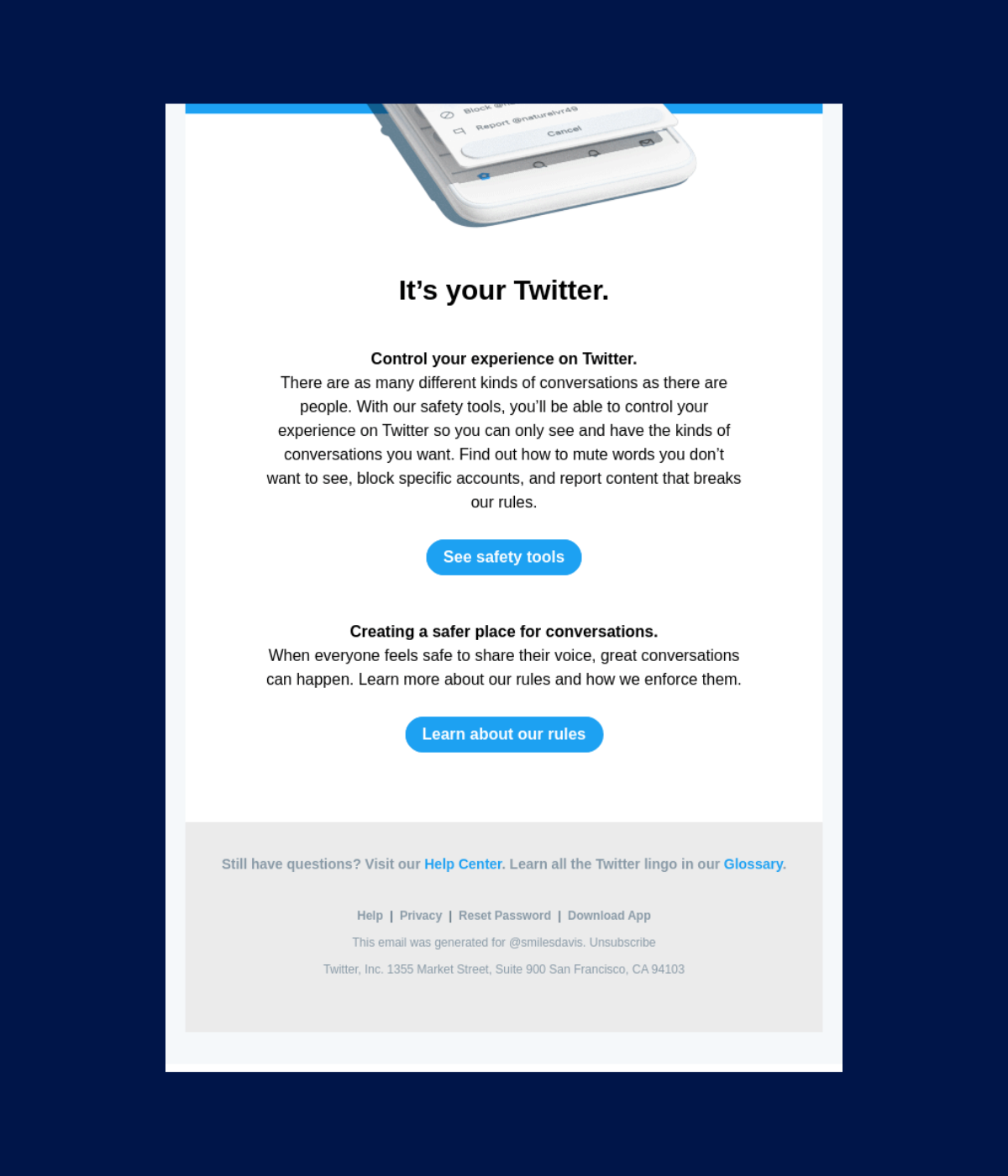
Like most businesses, you probably include links in the email footers that point to your website, social media pages, or the latest blog post.
But did you know that you can track these links to see how many people are clicking on them?
This information can be valuable in helping you understand what type of content the subscribers are interested in and how effective the marketing strategy is.
To set up link tracking, simply add a UTM tracking code to the end of each link in the email footer. When someone clicks on the link, they'll be redirected to a page that records their visit. This can also be done by creating a QR code. Add the same UTM tracker to the QR code and place it in your footer. By reviewing this data periodically, you can better understand which links are getting the most attention and adjust your marketing strategy accordingly.
When designing an email footer, it's important to stick to a clear structure and hierarchy. This means using headings and subheadings, and bullet points to organize the information making it skimmable.
Athletic Green follows a clear structure and a hierarchy when they design their email footers. It can be clearly seen that they first show their logo followed by the links to their social media platforms. At the bottom, they have an unsubscribe link.
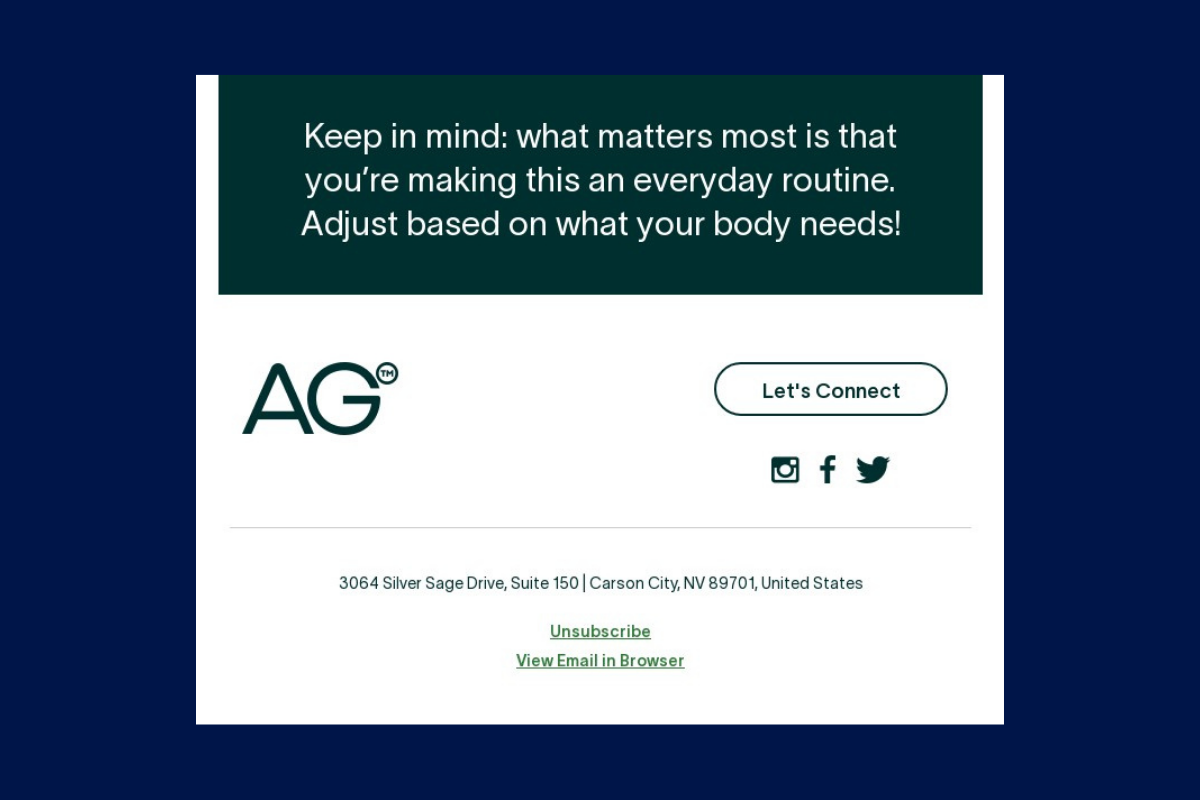
If you have a lot of information that you want to include in the email footer, consider adding a menu. This will let recipients quickly find the information they're looking for without scrolling through the entire message. To add a menu, simply create a list of links and add them to the bottom of your email.
Take a look at how Slack incorporates information by creating a menu. It helps the recipients to effectively browse through the features that Slack offers.

Adding a personal touch to the email footer is a great way to stand out from the competition. This can be as simple as adding a photo or including a personal message. If you're sending business emails, you may want to consider adding the company's logo to the footer.
Look at how The Farmers Dog, a pet food brand, has personalized the email footer. The line “Like puppies? We’re well socialized” adds a personal touch and catches the attention of the recipient.

An email footer is an important component of an email. Without a compelling email footer, recipients wouldn’t be able to find your contact information, privacy policy, and manage preference links. Consequently, your conversion rate will drop as well.
By incorporating these email footer best practices into your email designing process, you can make your email marketing campaigns achieve more than you initially set out to achieve.
There is no definitive answer to this question. However, it is generally accepted that email footers should be between 500 and 700 pixels wide. Anything wider than this may make the footer appear stretched out on some screens, making it difficult to read.
To add an email footer in Outlook, go to the File tab and select Options. In the Options dialog box, select Mail. Under Message format, select HTML or Plain Text as your format. In the Signature section, click the New button. Enter a name for your signature and click OK. In the Edit signature box, enter your signature information and click OK.
To add an email footer in Gmail, go to the Settings cog in the top right corner of your screen and select See all settings. Under the General tab, scroll down to the Signature section. Enter your signature information in the box provided and click Save Changes.
A voracious reader and a music lover, Ammar has been writing engaging and informative content for over 3 years for B2B and B2C markets. With a knack for writing SEO-optimized content, Ammar ensures the results speak for themselves.
Tags:

M. Usama
April 19, 2024

M. Usama
April 19, 2024

M. Usama
April 18, 2024